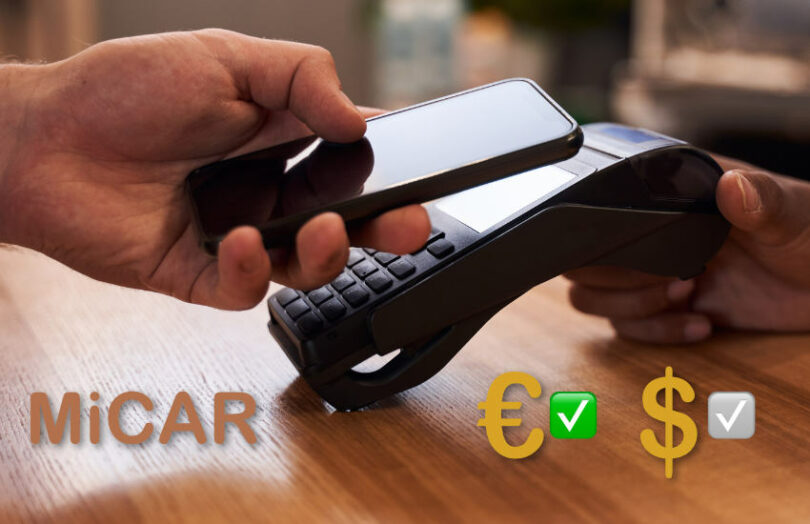A few press reports have raised concerns about stablecoin limits under the European Union’s Markets in Crypto Assets Regulation (MiCAR). The stablecoin elements of the regulation came into force at the end of June. The regulation does indeed have some draconian limits, at which point the stablecoin must cease activity. However, the limits explicitly avoid targeting stablecoin usage in the crypto world, or investments more broadly. The European Banking Authority has relaxed the rules in its final iteration.
The EU is saying if you want to use stablecoins to buy crypto and do DeFi stuff, have at it. But if you want to use stablecoins to pay for goods and services like your coffee or your rent, then you need to use Euro (or other EU currency) stablecoins. The limits are really about monetary sovereignty.
Hence, it does not impose limits on Euro or EU currency e-money style stablecoins. The limits apply to foreign currency e-money tokens (EMTs) and asset-referenced stablecoins (ARTs). With ART stablecoins, the digital currency’s peg links it to multiple currencies, commodities, crypto or other assets. Facebook’s Libra/Diem is a good example.
If a foreign currency or ART stablecoin issuer gets too big with real world transactions, it will have to stop or contract real world usage, or regulators will shut down the stablecoin.
Currently, stablecoins aren’t used a lot for everyday payments, although that’s expected to increase over time.
However, a bigger potential issue relates to using stablecoins as a settlement asset for real world asset tokenization. As explained below, most of these sorts of transactions do not count towards the limits. So non EU currency stablecoins can be used to settle (potentially large) tokenization transactions without being concerned about restrictions.
The EU’s stablecoin limits
So what are the limits? Issuance has to cease when the daily usage “as a means of exchange within a single currency area is higher than 1 million transactions and EUR 200 000 000.” (MiCAR, Article 23.1)
To put these figures in context, the daily transactions on Tether were between $15 billion and $67 billion during June. The vast majority of this is for crypto transactions which don’t count towards the €200 million, which again only applies to real world payments within the EU.
The final draft rules exclude several large groups of transactions from the figures. It doesn’t count transactions where one party is outside the EU. Investment-related transactions are excluded. This is not just crypto investment transactions, it relates to any investments.
The text in the MiCAR article isn’t that precise, but there is a preamble (recital) in the regulation that provides context about the EU’s intent that it’s relaxed about crypto usage but not so much everyday usage for goods and services (other than Euro linked).
One critical point is these limits explicitly apply to foreign e-money tokens, so it covers USDC and Tether usage within the EU.
The wording raises quite a few questions, such as what is a ‘means of exchange’? What is meant by ‘within a single currency area’? And how on earth are you going to figure out how people use the stablecoin?
The EBA consultation
The European Banking Authority (EBA) ran a consultation about its planned implementation of the rules and published a summary of responses. It appears to be willing to concede quite a bit of ground and has published its final draft. The next steps are a European Commission endorsement and a review by the European Parliament and Council.
To assess whether a stablecoin has breached these limits, the stablecoin issuer has to make a quarterly report of the figures (Article 22.1). The regulation also requires crypto-asset service providers (CASPs) to provide data to the stablecoin issuer, including transactions it records off chain. Remember a lot of crypto exchange transactions never touch the underlying blockchains, hence the off chain request.
The EBA’s first concession is it doesn’t require the issuer to report transactions between non-custodial wallets. We’d note that crypto firms use stablecoins to pay staff and freelancers. Technically, that’s payment for goods and services. Both of these groups are more likely to self custody, hence these transactions won’t be counted in the €200m/day figure. However, both sides of the transaction have to self custody their stablecoins.
Means of exchange
Consultation respondents asked whether collateral and derivatives would be counted in the ‘means of exchange’. The EBA doesn’t intend for them to be counted. The wording used in the rules is extremely favorable:
The issuer should calculate the estimate referred to in Article 22(1)(d) of MiCAR by deducting from the total number and value of transactions with an ART during the relevant quarter:
(a) transactions where the ART is exchanged for funds or other crypto-assets with the issuer or with a CASP;
(b) transactions where the ART is used as collateral for the purpose of conducting transactions with financial instruments;
(c) transactions where the ART is used to settle a derivative contract; and
(d) other transactions where the issuer has reasonable grounds to assume that the purpose of the respective transactions with the ART is not to pay for goods or services.
What we consider to be particularly favorable is the reference to ‘financial instruments’, because that’s not crypto. Likewise, it refers to a ‘derivative contract’ not a crypto-asset derivative contract. So from a real world asset tokenization perspective, that’s good news. Based on the MiCAR preamble (recital), the EBAs interpretation is consistent with the legislator’s intent because it stated that the limit should not include “transactions associated with investment functions and services, such as a means of exchange for funds”.
The MiCAR preamble also discussed transactions where a stablecoin is used as an intermediary instrument for payment. For example, crypto exchanges allow clients to use their crypto for retail payments using exchange branded Visa and Mastercard cards. When a user makes a payment at a coffee shop using Ether, in reality the Ether is switched to a stablecoin which is used for a payment. Even though the user thinks they’re paying in Ether, these transactions count towards the stablecoin limits.
What’s meant by ‘within a single currency area’
The EBA’s first draft counted transactions within the EU but between say a Euro country resident and a Swedish resident. Sweden does not use the Euro. Consultation respondents argued that ‘within’ meant both parties are either in a euro area or say the Swedish krona ara. The EBA conceded on that point.
Consultation respondents also argued that this wording excludes transactions where one party is outside of the EU. The EBA was far more reluctant on this point, but also conceded. Its reluctance related to monetary sovereignty concerns. However, it noted that MiCAR gives the authorities pretty wide powers to deal with monetary sovereignty threats.
The EBA also warned there’s a good chance that in the future there could be additional reporting requirements for cross border transactions.
All in all, while the monetary limits sound draconian, the impact today is probably minimal. However, for stablecoin issuers looking to get more involved in retail payments, within the EU they will need to target Euros rather than the dollar.






